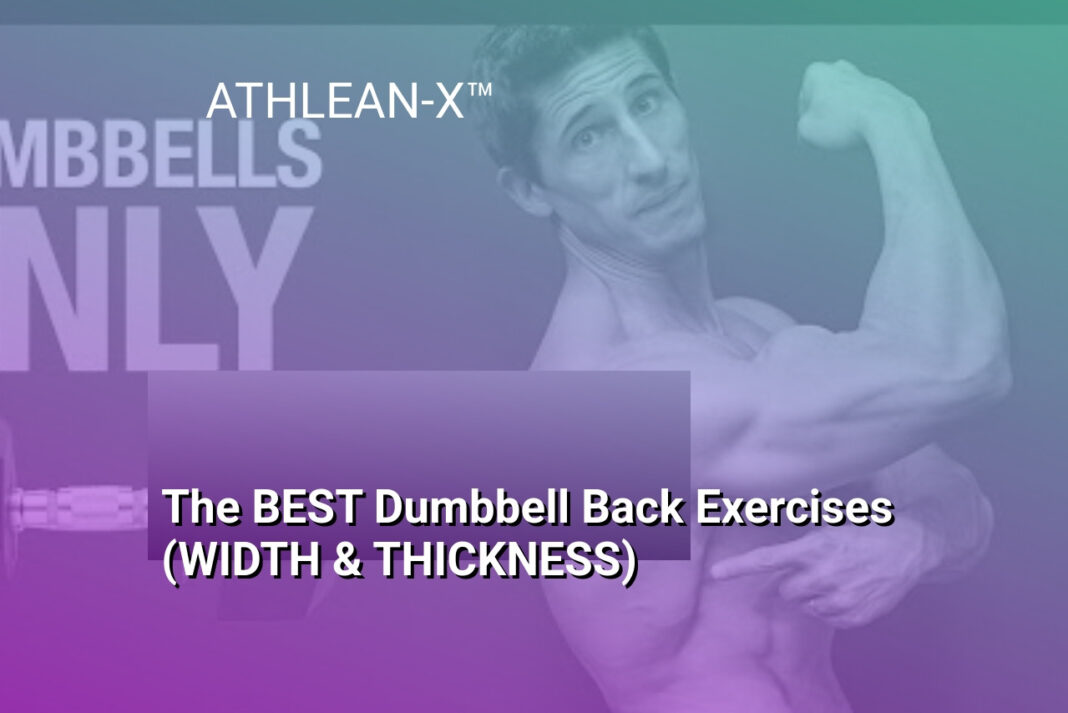The Bottom Line:
Here’s the summary in the requested format:
- I discovered that dumbbells are incredibly versatile for back training, offering multiple approaches to strength development, muscle growth, and rehabilitation without relying solely on traditional gym equipment.
- Explosive movements like Dumbbell Dead Rows and Gorilla Rows are game-changers for developing unilateral power and enhancing overall back muscle performance.
- Strategic exercises such as Tripod Rows and Chest Supported Rows provide targeted muscle tension and growth opportunities, allowing for safe and effective hypertrophy training.
- Corrective exercises like I’s, T’s, Y’s, and W’s are crucial for addressing muscle imbalances and preventing potential back injuries while promoting overall muscular health.
- By incorporating varied techniques from explosive movements to controlled tempo exercises, I learned that back training can be comprehensive, engaging multiple muscle groups and supporting long-term strength development.
Foundational Dumbbell Back Training Techniques
Mastering Single-Arm Dumbbell Rows
Single-arm dumbbell rows are a cornerstone exercise for developing back strength and muscle definition. By focusing on unilateral movement, these rows allow for targeted muscle engagement and help address muscular imbalances. Proper form is critical: maintain a stable base with one hand supporting your body on a bench, keep your back parallel to the ground, and pull the dumbbell towards your hip while maintaining a neutral spine. The key is to control the weight throughout the entire range of motion, emphasizing a slow eccentric (lowering) phase to maximize muscle tension and growth potential.
Progressive Overload Strategies for Back Development
Implementing progressive overload is essential for continuous back muscle growth when using dumbbells. This involves systematically increasing weight, repetitions, or training volume over time. Start by selecting a weight that allows you to perform 8-12 repetitions with proper form, then gradually increase the load as your strength improves. Techniques like drop sets, where you reduce weight and continue performing repetitions after reaching muscle failure, can also stimulate additional muscle growth and enhance overall back development.
Stabilization and Muscle Engagement Techniques
Effective dumbbell back training goes beyond simple lifting movements. Focus on creating total body tension and maintaining proper stabilization during exercises. Engage your core muscles, keep your shoulder blades retracted, and concentrate on squeezing the targeted back muscles during each repetition. Incorporate variations like bent-over rows, renegade rows, and supported rows to challenge your muscles from different angles and prevent adaptation. By emphasizing mind-muscle connection and deliberate movement patterns, you’ll maximize muscle recruitment and minimize the risk of injury during your dumbbell back workouts.
Explosive Power Development for Back Muscles
Unleashing Unilateral Power Dynamics
Explosive back muscle development requires strategic unilateral training approaches that challenge muscular coordination and neuromuscular recruitment patterns. By incorporating single-arm dumbbell movements, athletes can address muscular imbalances while simultaneously stimulating rapid force production. Exercises like single-arm dumbbell rows with controlled explosive concentric phases create significant neural adaptations that translate into enhanced muscle fiber recruitment and overall back strength.
Dynamic Acceleration Techniques
Implementing acceleration-focused techniques transforms traditional dumbbell back exercises into powerful muscle growth stimulators. The key lies in manipulating tempo and momentum during movements like renegade rows and explosive dead rows. By intentionally increasing lifting speed during the concentric phase and maintaining strict control during eccentric movements, practitioners can generate substantial metabolic stress and mechanical tension. This approach triggers enhanced muscle protein synthesis and neurological adaptations that contribute to both strength and hypertrophy.
Plyometric Integration Strategies
Advanced back muscle development demands incorporating plyometric principles into dumbbell training. Techniques such as drop sets, rapid-fire repetitions, and controlled momentum shifts create unique neuromuscular challenges that push muscular adaptation beyond traditional linear resistance training. Exercises like explosive gorilla rows and dynamic man makers integrate full-body power generation while specifically targeting posterior chain muscles. These complex movements not only develop raw muscular strength but also improve overall athletic performance by enhancing inter-muscular coordination and rapid force production capabilities.
Hypertrophy-Focused Rowing Variations
Strategic Unilateral Rowing Techniques
Unilateral rowing variations provide exceptional muscle stimulation by targeting each side of the back independently. Single-arm dumbbell rows create asymmetrical tension, forcing stabilizer muscles to engage more intensely while preventing muscular imbalances. By focusing on one side at a time, lifters can concentrate on precise muscle contraction and maintain superior form throughout the movement. The unilateral approach allows for greater range of motion and enhanced mind-muscle connection, critical factors in driving hypertrophic adaptations.
Tempo and Time Under Tension Protocols
Manipulating rowing tempo becomes a powerful mechanism for muscle growth, particularly when emphasizing eccentric and isometric phases. Implementing controlled 3-4 second lowering phases increases muscle damage and metabolic stress, two primary drivers of hypertrophy. Incorporating pauses at peak contraction points further intensifies muscular recruitment, creating significant mechanical tension. Lifters can progressively overload by gradually reducing rest periods between sets or increasing total time under tension, ensuring continuous muscular adaptation and growth stimulus.
Advanced Rowing Complexity and Variation
Introducing complexity to traditional rowing movements can dramatically enhance muscle recruitment and prevent adaptive plateaus. Techniques like alternating between traditional and rotational rowing patterns, incorporating partial repetitions, and utilizing different grip orientations challenge the muscular system from multiple biomechanical angles. Implementing drop sets, where weight is reduced midset to extend muscle fatigue, or integrating pause reps can create additional metabolic stress and muscular microtrauma necessary for substantial hypertrophic responses. By continuously challenging the back musculature through strategic variation, lifters can optimize muscle growth potential and maintain consistent progression.
Corrective Exercises and Back Health Strategies
Rehabilitation and Muscular Balance Techniques
Corrective exercises play a crucial role in maintaining back health and preventing potential injuries during intense dumbbell workouts. Implementing strategic movements that target stabilizer muscles and address muscular imbalances can significantly improve overall back strength and resilience. Practitioners should focus on low-weight, high-precision movements that activate often-neglected muscle groups and promote proper movement patterns.
Foundational Mobility and Stability Protocols
Integrating mobility drills such as I’s, T’s, Y’s, and W’s can help restore proper shoulder blade positioning and activate deep postural muscles. These lightweight exercises engage different segments of the posterior chain, helping to correct alignment issues and reduce the risk of chronic back strain. By performing these movements with controlled tempo and minimal weight, individuals can enhance neuromuscular communication and build a more stable muscular foundation.
Strategic Recovery and Injury Prevention
Incorporating techniques like the reverse hyper and targeted stretching can provide substantial benefits for back health. These methods help decompress the spine, strengthen supporting muscle groups, and create space between vertebrae. Practitioners should prioritize movements that promote spinal decompression and focus on maintaining proper form during all back-related exercises. Implementing a comprehensive approach that balances strength training with mobility work ensures long-term muscular development and reduces the likelihood of workout-related injuries.
Advanced Trap and Total Body Back Movements
Explosive Unilateral Power Training
Unilateral dumbbell movements provide exceptional opportunities for developing back strength and muscle asymmetry correction. The Gorilla Row represents a pinnacle exercise in this category, allowing lifters to generate explosive power while maintaining a stable core position. By alternating rowing movements between sides, athletes can address muscular imbalances and stimulate significant neuromuscular adaptations. The key is maintaining a rigid torso and generating power through the lats and rhomboids during each repetition.
Advanced Trap Muscle Engagement Techniques
Targeting trapezius muscles requires strategic dumbbell selections and precise movement patterns. Beyond traditional shrugs, advanced lifters can incorporate complex movements like dumbbell high pulls and farmer’s walks to create comprehensive trap development. High pulls specifically engage multiple shoulder and upper back muscle groups simultaneously, generating tremendous metabolic stress and promoting hypertrophic responses. The critical factor involves maintaining controlled eccentric movements and maximizing time under tension throughout each repetition.
Total Body Integration Protocols
Complex dumbbell movements like Man Makers represent the pinnacle of total body back training. These integrated exercises combine multiple movement patterns—including push-ups, rows, and explosive transitions—to create comprehensive strength challenges. By incorporating full-body dynamic movements, athletes can simultaneously develop back muscles while improving cardiovascular conditioning and overall metabolic efficiency. The key is maintaining strict form and progressively increasing complexity as strength and coordination improve.
Implementing these advanced techniques requires careful progression, understanding individual biomechanical limitations, and maintaining consistent technical execution. Lifters should prioritize movement quality over absolute weight, ensuring each repetition contributes meaningfully to muscular development and injury prevention.





